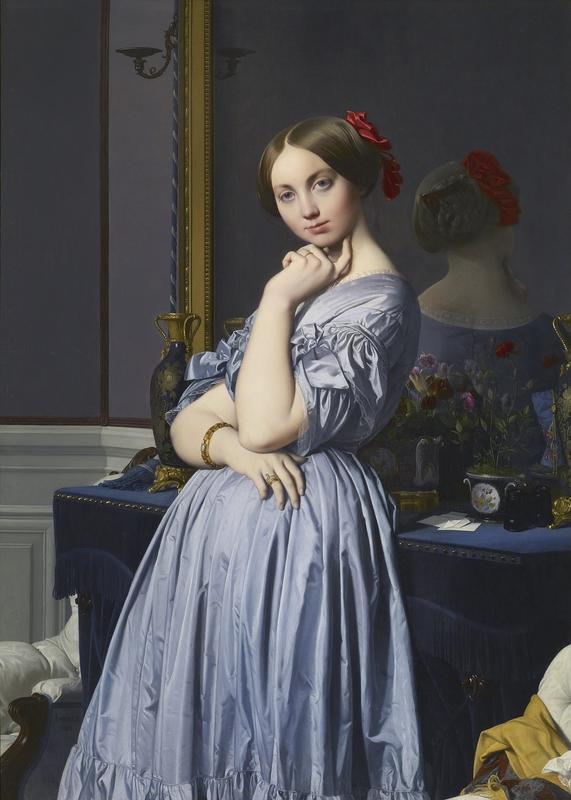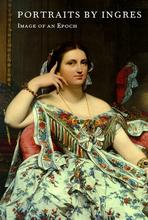More about Comtesse d'Haussonville
- All
- Info
- Shop

Contributor
When Ingres completed this portrait of Louise de Broglie, Comtesse d'Haussonville, which was commissioned by the sitter's husband, the Viscount Othenin d'Haussonville, her official title was Viscomtesse.
In the esoteric language of peerage, that means she upgraded a step when she became a Comtesse. At the time, Ingres was simultaneously working on a portrait of the Madame de Rothschild, and that was not a commission to mess up on, so it took him a few years to finish this one. Not that the Viscomtesse was playing second fiddle to the Madame de Rothschild or anything. The Viscount was a diplomat, so Ingres had to be diplomatic with this commission.
Like Samuel Morse across the pond, Ingres was annoyed by the fact that the cash cow was society portraiture, or "face painting," as Morse called it. Everybody wanted beautiful images of themselves like this one, but Ingres wanted to do history paintings in the spirit of his master, Napoleon's Don Draper, Jacques-Louis David. This reluctance to use his skills for portraiture is one of the many reasons that he took three years to finish the Comtesse d'Haussonville.
Seven years before he started this work, Ingres arrived at Rome's Villa Medici at two in the morning to take up a position running the place, which was a sort of study retreat for pensioners. Unlike his extroverted predecessor, Ingres was reserved and cultivated a conservative, subdued vibe. Under Ingres, "Everything was somber and gloomy: a lamp in each corner of this immense room, made even darker by the tapestries decorating it," Imagine Madeleine Chapelle Ingres knitting while Monsieur Ingres acts as the life of the downtempo party, conversing with people with a quiet seriousness that commanded your attention. Very few non-Italians got past the red rope and bouncers of Ingres's VIP lounge--one of the few who made the cut was the Swiss-born Viscomtesse--she met Ingres at the Villa two years before he started on this portrait.
During that visit, the Viscomtesse also saw a canvas in which Ingres depicted Stratonice of Syria in a pose with her hand below her chin, similar to the pose in this work. The Viscomtesse, who composed books, including a biography of Byron, wrote that the composition of the Stratonice work "recalls the paintings of Herculaneum," an ancient city preserved, like Pompeii, by the outburst of a local loose-cannon volcano. Ingres's portrayal of this gesture of contemplation from the Comtesse was a direct influence on Henri Lehmann's portrait of Marie d'Agoult. Somehow, the ample anatomical and perspectival impossibilities in this work make it look even better, anatomy be darned.
Ingres was not happy with this painting as he believed that he had not adequately captured the young woman's charms. However, the Viscomtesse and her family were quite pleased with the result, and one French nobleman even noted that, "M Ingres must be in love with you to have painted you that way," a salacious comment Ingres described as "wicked."
Sources
- Bergman-Carton, Janis. The Woman of Ideas in French Art, 1830-1848. New Haven: Yale University Press, 1995.
- Betzer, Sarah E. Making Modern Paris: Victor Baltard's Central Markets and the Urban Practice of Architecture. University Park, PA: Penn State Press, 2012.
- Knight, Christopher. "Critic's Notebook: Ingres' 'Comtesse d'Haussonville' @ Norton Simon Museum." Los Angeles Times, Nov. 2, 2009, https://latimesblogs.latimes.com/culturemonster/2009/11/critics-noteboo…
- Lehmann, John. Ancestors and Friends. London: Eyre & Spottiswoode, 1962.
- Pomarède, Vincent, et al. Ingres: 1780-1867. Paris: Gallimard, 2006.
- Ritchie, Andrew Carnduff. "The Evolution of Ingres' Portrait of the Comtesse d'Haussonville." The Art Bulletin 22, no. 3 (Sep. 1940): 119-126.
- Trachtenberg, Alan. Reading American Photographs: Images As History-Mathew Brady to Walker Evans. New York: MacMillan, 1990.
Featured Content
Here is what Wikipedia says about Portrait of Comtesse d'Haussonville
The Portrait of Comtesse d'Haussonville is an 1845 oil-on-canvas painting by the French Neoclassical artist Jean-Auguste-Dominique Ingres. The sitter was Louise de Broglie, Countess d'Haussonville, of the wealthy House of Broglie. The Princesse de Broglie, who Ingres later portrayed c. 1851–53, was married to Louise's brother Albert de Broglie, the French monarchist politician, diplomat and writer. Highly educated, Louise de Broglie was later an essayist and biographer and published historical romance novels based on the lives of Lord Byron, Robert Emmett and Margaret of Valois.
The painting is one of the few portrait commissions Ingres accepted at the time, as he was more interested in Neoclassical subject matter, which, to his frustration, was a far less lucrative source of income than portraiture. He had made a preparatory sketch and had begun an oil and canvas version two years earlier, but abandoned the commission when de Broglie became pregnant and was no longer able to pose for the long periods he required, and she had anyway found interminable and "boring". The final work is signed and dated at the lower left.
Check out the full Wikipedia article about Portrait of Comtesse d'Haussonville













